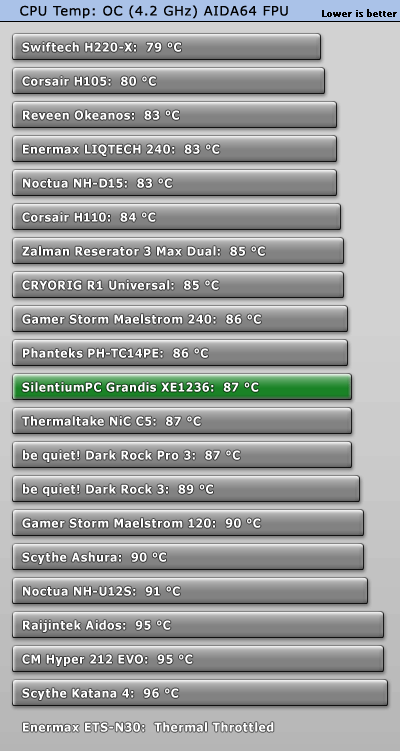 14
14
SilentiumPC Grandis XE1236 Review
Noise Levels & Fan Speeds »Test System and Temperature Results
Test System
| Test System | |
|---|---|
| Processor: | Intel Core i7-4770K @ 3.7 GHz & 4.2 GHz OC (Haswell) |
| Motherboard: | MSI Z87-GD65 Gaming Intel Z87 |
| Memory: | 2x 4096 MB AMD Performance Edition AP38G1869U2K @ 1600 MHz 9-9-9-24 |
| Video Card: | AMD Radeon HD 5450 1 GB Passive |
| Hard disk: | OCZ Vertex Plus R2 60 GB SATA II SSD |
| Power Supply: | Deepcool Quanta DQ1250 1250W |
| Case: | LIAN LI PC-T60B |
| Operating System: | Windows 7 64-bit Service Pack 1 |
| TIM: | Arctic Ceramique 2 |
Testing Procedure
All testing is done at a room temperature of 23°C (73°F), with a 1°C margin of error. The coolers are tested with Turbo, EIST, and C1E enabled, which will allow the CPU to clock down to a low 1.6 GHz while idle, or clock up to proper speeds under stock and overclocked conditions. The retail Intel Core i7-4770K I use for testing at stock is set to load-optimized defaults with the CPU's voltage at a static 1.15 V. Overclocked, the processor is running at 4.2 GHz on the CPU and 3.9 GHz on cache, with respective voltages set to 1.20 V and 1.15 V. During all these tests, fans are set to run at 100% in the BIOS, with temperatures being recorded by AIDA64.The idle test will consist of the CPU sitting idle at the desktop for 15 minutes. This will allow for a stable temperature reading that will be recorded at the end of those 15 minutes.
Wprime's and AIDA64's CPU test represent typical multi-threaded loads. Both offer consistent results, with one being a benchmarking application and the other a stability test. Both are run for 15 minutes before the peak reading during the test is recorded and taken as the result. This test lets enthusiasts know what temperatures they can expect to see with games and applications. Wprime is set to eight threads while AIDA64 is configured to stress the CPU, FPU, cache, and system memory.
AIDA64 offers maximum heat generation when set to stress just the FPU in the stability test, which will really push the CPU. This test represents extreme loads much like LinX, Prime95, and other extreme stress tests many users are familiar with.
Idle Temperatures


The Grandis XE1236 did relatively well in idle. Temperatures only hit 29°C at stock and 31°C with the CPU overclock.
Typical Load Temperatures


The Grandis XE1236 does well in the Wprime test, performing as well as the Phanteks PH-TC14PE and be quiet! Dark Rock Pro 3 at stock and beating both when the CPU is overclocked. This was definitely an unexpected result.


The heavier workload with AIDA64's CPU stability test had the Grandis XE1236 fall back behind the Phanteks and be quiet! coolers at stock. However, some lost ground was made up for once the CPU had been overclocked.
Max Load Temperatures


How much value SilentiumPC's Grandis XE1236 offers becomes evident once the work load has been cranked up with AIDA64's FPU test. With temperatures hitting 73°C at stock and 87°C with the CPU overclocked, the Grandis XE1236 manages to compete with the Phanteks PH-TC14PE and Dark Rock Pro 3, even though only half their price.
May 4th, 2025 22:04 EDT
change timezone
Latest GPU Drivers
New Forum Posts
- Request for advice [Big Build] (50)
- What are you playing? (23545)
- Are the 8 GB cards worth it? (842)
- ASRock Z590 OC Formula. (34)
- Subsystem Id of my Asus Strix RTX 4090 OC / Random GPU detection problem (33)
- Best USB 3 hub chipsets (18)
- Half Life 3 soon ? (12)
- RX 9000 series GPU Owners Club (636)
- is it possible to buy a sata to propietary dell pata adapter? (1)
- 12600KF high latency (24)
Popular Reviews
- ASUS ROG Maximus Z890 Hero Review
- ASUS Radeon RX 9070 XT TUF OC Review
- Clair Obscur: Expedition 33 Performance Benchmark Review - 33 GPUs Tested
- Montech HS02 PRO Review
- NVIDIA GeForce RTX 5060 Ti 8 GB Review - So Many Compromises
- Seasonic Vertex GX 850 W Review
- Upcoming Hardware Launches 2025 (Updated Apr 2025)
- ASUS GeForce RTX 5090 Astral Liquid OC Review - The Most Expensive GPU I've Ever Tested
- Sapphire Radeon RX 9070 XT Nitro+ Review - Beating NVIDIA
- AMD Ryzen 7 9800X3D Review - The Best Gaming Processor
Controversial News Posts
- AMD Radeon RX 9060 XT to Roll Out 8 GB GDDR6 Edition, Despite Rumors (129)
- NVIDIA Sends MSRP Numbers to Partners: GeForce RTX 5060 Ti 8 GB at $379, RTX 5060 Ti 16 GB at $429 (128)
- NVIDIA Launches GeForce RTX 5060 Series, Beginning with RTX 5060 Ti This Week (115)
- Nintendo Confirms That Switch 2 Joy-Cons Will Not Utilize Hall Effect Stick Technology (105)
- NVIDIA PhysX and Flow Made Fully Open-Source (95)
- Sony Increases the PS5 Pricing in EMEA and ANZ by Around 25 Percent (84)
- Parts of NVIDIA GeForce RTX 50 Series GPU PCB Reach Over 100°C: Report (78)
- Intel "Bartlett Lake-S" Gaming CPU is Possible, More Hints Appear for a 12 P-Core SKU (77)